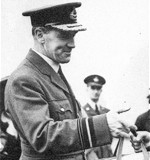Quintin Brand
| Sir Quintin Brand | |
|---|---|

AVM Brand visiting an air base c. 1941
|
|
| Nickname(s) | "Flossie" |
| Born |
25 May 1893 Beaconsfield, South Africa |
| Died | 7 March 1968 (aged 74) Umtali, Rhodesia |
| Allegiance | South Africa United Kingdom |
| Service/branch |
Union Defence Force Royal Air Force |
| Years of service | 1913–1943 |
| Rank | Air Vice Marshal |
| Commands held |
No. 20 Group (1941–43) No. 10 Group (1940–41) No. 56 Squadron (1923–25) No. 44 Squadron (1919) No. 151 Squadron (1918–19) No. 112 Squadron (1918) |
| Battles/wars |
First World War Second World War |
| Awards |
Knight Commander of the Order of the British Empire Distinguished Service Order Military Cross Distinguished Flying Cross Order of Ismail (Egypt) |
Air Vice Marshal Sir Christopher Joseph Quintin Brand KBE, DSO, MC, DFC (25 May 1893 – 7 March 1968) was a South African officer of the Royal Air Force.
Brand was born in Beaconsfield (now part of Kimberley, Northern Cape) in South Africa to a CID Inspector in the Johannesburg police. He joined the South African Defence Force in 1913.
During the years 1914–1915, Brand continued to serve in the Union Defence Force.
In 1915, Brand travelled to England where he transferred to the Royal Flying Corps. He learned to fly and was awarded Royal Aero Club Certificate No 3949 on 30 March 1916. During the First World War, he flew Nieuport 17 scouts, serving in No. 1 Squadron RFC in France as a Flight Commander before being posted back to England.
In February 1918, Brand became commander 112 Squadron, a home defence night fighter squadron equipped with specially modified Sopwith Camels flying from Throwley in Kent, shooting down a Gotha bomber over Faversham on 19 May. He was then appointed commander of No. 151 Squadron RAF at Fontaine-sur-Maye in France, a night fighter squadron formed to combat German night raids over the Western Front. The squadron downed 26 German aircraft with Brand himself shooting down four, becoming the highest scoring RAF night fighter pilot of the First World War. Brand claimed 12 victories in 1917 and 1918 (seven victories with No 1 Squadron, four with 151 Squadron and one with 112 Squadron) and was awarded the Distinguished Flying Cross during this period.
...
Wikipedia
